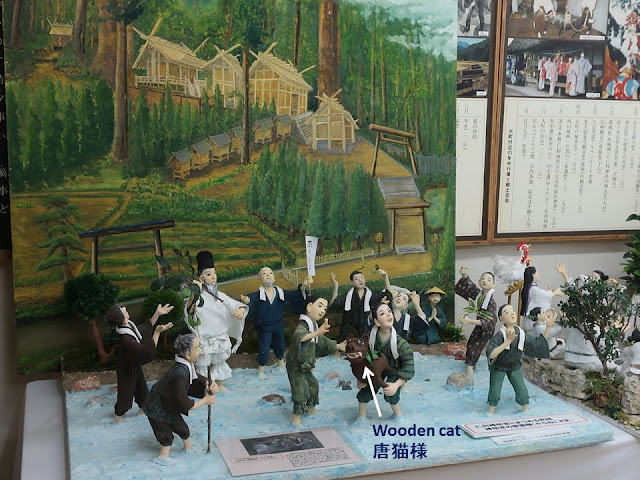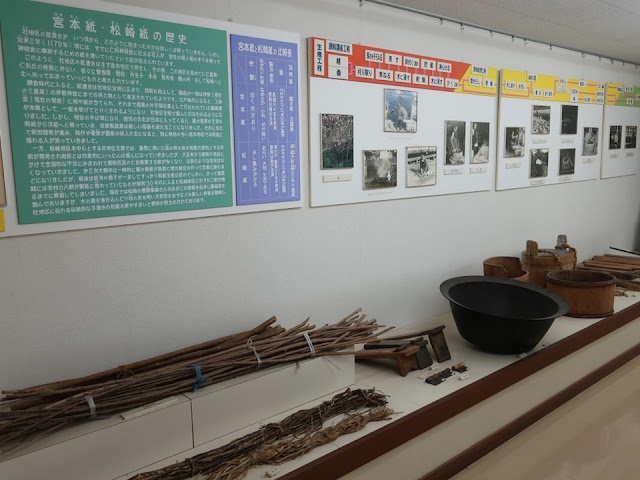Omachi city in central Japan is famous for the gateway of “Tateyama Kurobe Alpine Route”, which is very popular sightseeing route (https://www.alpen-route.com/en/). Omachi was also a post-town on the Chikuni highway, which linked Matsumoto (inland city) and the Sea of Japan; salt and so on were brough to inland region through the highway. The museum is in a community center which was a school.
I could know that the locals respect
Nishina Shrine, traditional events and industry (Japanese paper). However, I
could not find the fun things for them unfortunately.
長野県大町市は、立山黒部アルペンルートの信州側起点として有名です。民俗資料館は元校舎で、公民館に併設されています。かつては、新潟県の糸魚川と松本を結ぶ千国街道の宿場町でした。日本海の塩を松本平へ運んだルートで塩の道と呼ばれています。
本殿が国宝に指定されている仁科神明宮(後半で紹介)、地域に伝わる行事、特産の和紙を大切にしていることが分かりましたが、人々が何を楽しみにしているかは、残念ながら掴めませんでした。
There are two exhibition rooms on the right and one exhibition room on the left.
展示室は右側の二室と左側の一室です。
Exhibition room 1、特別展示室
Folklore events such as a festival are exhibited.
祭りなどの民俗行事が展示されています。
The model above shows a folk story praying for rain. People bound a wooden cat statue in Nishina Shrine to a raft, then threw it in to the river; they quickly picked it up and returned it to the shrine. Afterward, it started to rain. It was something cruel.
仁科神明宮にまつわる雨乞い行事の民話です。唐猫様(からねこさま、90cmほどの木造)の筏状の丸太にしばりつけ、川に流してから拾い上げ、神明宮に戻すと雨が降ったそうです。背景の絵は神明宮です。
The event on the left is held in July. A boy on a horse shoots an arrow (yabusame ritual); he is cool! It is said that the event originated in 1221, when a samurai warrior did it before going into battle. The event on the right is held in August. People float a straw boat on a stream for their ancestors. It is a kind of the Bon events.
馬上の子供が矢を射る流鏑馬神事(左、7月)、灯籠流し(右、8月)。子供はいい目をしていますね。流鏑馬神事は、1221年に後鳥羽上皇の北条義時追討の宣旨を受けた仁科盛遠が、出陣の時に神前に流鏑馬を奉納し、武運を祈ったことに始まるとされているそうです(https://www.82bunka.or.jp/bunkazai/legend/detail/07/post-33.php)。
In a tanabata star festival on the 7th of August, flat dolls are hung. It is a particular event to the region. A kimono (native dress, on the right end) is also hung.
8月7日に行われる七夕では、人形を吊します。松本平特有ですが、着物そのものを掛ける七夕飾りもあります。
Exhibition room 2、企画展示室
Exhibits about the former school were shown in the room above.
学校だった時代の紹介です。
A group photo of a class of an elementary school in around 1899.
村立の社尋常小学校・木舟分教場の写真。1899(明治32)年頃。
The one above was taken in 1922. Their clothes became better, and three teachers in behind wore western suits. Times had changed only over twenty years.
1922年3月の社尋常小学校・高等小学校の写真です。半纏に袴、生徒達の着るものがよくなっています。洋装の先生が三人います。時代が変化していますね。
Textbooks in the Meiji period (1868-1912) tell us how students studied.
明治時代の教科書。勉強の後が窺えます。
Exhibition room 3、小展示室
Exhibits about local paper and so on are displayed. Two kinds of papers were manufactured; white and glossy paper was used for documents, sliding door (shoji) and so on. A bit gray paper called “Matsuzaki paper” was used for daily use items such as a bag. Matsuzaki-wasi company manufactures paper even until now. They offer a factory tour and a paper making workshop (https://www.shinshu-matsusakiwashi.com/experience, in Japanese). It is an important industry especially for locals.
特産品の宮本紙、松崎紙の製造工程と古代の発掘物が展示されています。白くて光沢がある宮本紙は障子や文書紙に使われ、少し黒みがある松崎紙は、袋などの実用品に使われました。今も、「信州松崎和紙工業」の工場が大町市社にあり、工房の見学や紙漉き体験ができます(https://www.shinshu-matsusakiwashi.com/experience)。地元の人達が松崎紙を大切にしていることが分かります。
Visited in September, 2023
Official website: https://www.city.omachi.nagano.jp/00025000/00025700/00025702.html
(in Japanese), accessed in July, 2024
History
exhibition hall of Nishina Shinmeigu
(shrine)、仁科神明宮・歴史展示館
A powerful clan called “Nishina” invited a
deity from Ise Shrine and enshrined
it in Nishina shrine. They also offered foods to Ise Shrine.
仁科神明宮は、豪族の仁科氏が伊勢から天照大神を勧進した神様です。仁科の土地は、天照大神に食事を差し上げる御厨でした。
The sacred approach leads to the main hall. The small building on the left is “History exhibition hall”. Even on a weekday, people visit constantly.
神聖な空気が漂う参道を本殿へと向かいます。右側の小さな建物が歴史展示館です。平日でしたがお参りの方が途絶えませんでした。
The main hall was rebuilt in 1636, which is the oldest hall of Shinmei-style. The hall, the hanged roof and the inner gate are designated as national treasures.
1636年に建て替えられた本殿は、その後、式年の修理だけで建て替えされず、現存する最古の神明造として本殿、中門とそれらをつなぐ釣屋が国宝に指定されています。
Panels and photos of the museum explain upon the shrine in detail.
歴史展示館では、パネルや写真で詳しく説明されています。
After a regular repair work of the hall, the deity dwelling object returns to the main hall. The ritual is held at night.
本殿の修善を終え、御神体を仮殿から遷宮した後の祝詞奏上。夜に行われます。
Current Kagura (Shinto music and dancing) and rituals are exhibited. The building at lower right is Kagura hall.
今も行われている神楽や神事も説明されています。右下は神楽殿です。
In the ritual of the beginning of farming on the 15th of March, they perform whole farming process and pray for rich harvest in the Kagura hall. The model above is the process of tilling by horse.
作始め神事では、神楽殿の床を水田に見立てて、一年間の農作業を演じ、豊作を祈ります。模型は馬鍬掻きの様子です。毎年3月15日に奉納されます。
The landscape of the Japanese Alps from the shrine gate was so impressive.
参道からは北アルプスの山々が綺麗に見えました。
Visited in October, 2023
Official website of Nishina Shinmeigu: https://www.sinmeigu.jp/index.html (in Japanese), accessed in July, 2024
Previous post (museum on the road from Matsumoto to the Sea of Japan): Daio
Wasabi Farm & Centennial Memorial Hall、大王わさび農場と百年記念館
Next post (museum in the same city which is on the road from Matsumoto to the Sea of Japan): Omachi Alpine Museum、大町山岳博物館



















Comments
Post a Comment